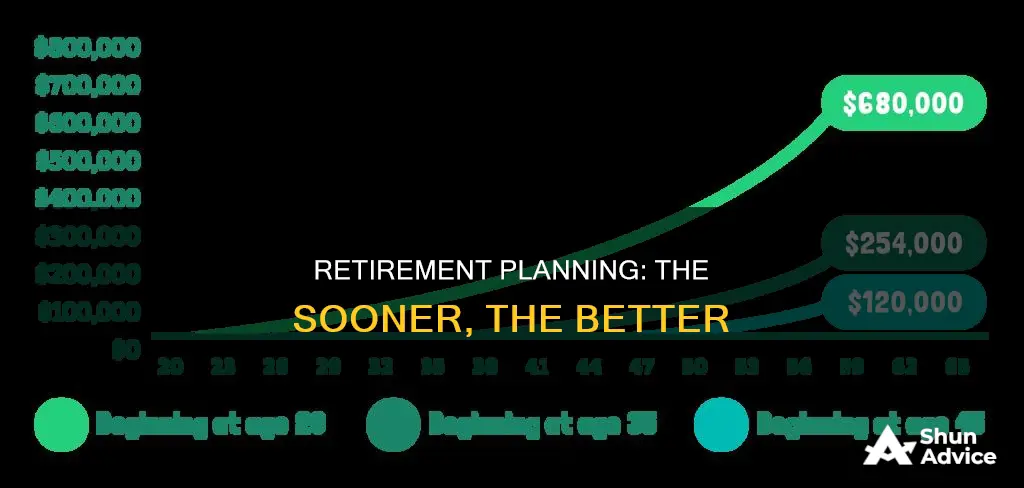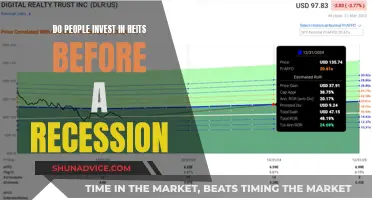
The simple answer to the question of when to start investing for retirement is: as early as you can. The power of compound interest means that the earlier you start investing, the more time your money has to grow. Even if you can only afford to put aside a small amount each month, this can add up to a substantial sum over time. For example, if you invest $100 a month from the age of 25, averaging a 12% annual return, you'll end up with over $1 million by the time you're 65. However, if you wait until you're 35 to start investing, you'd need to invest over 10 times as much each month to reach the same total.
While it's ideal to start saving early, the next best time to start investing for retirement is now.
| Characteristics | Values |
|---|---|
| Time to start investing | As soon as possible, ideally in your 20s |
| How much to invest | At least 10% of your income each month |
| Type of account | Tax-favoured retirement accounts like 401(k)s and IRAs |
| Benefits | Compound interest, tax benefits |
What You'll Learn

The earlier, the better
The earlier you start investing for retirement, the better. While it's never too late to start, financial experts advise that you should begin saving and investing for retirement as soon as you can. Ideally, you would start saving in your 20s, when you first leave school and begin earning paychecks.
The reason for this is that the sooner you begin saving, the more time your money has to grow. Each year's gains can generate their own gains the next year—a powerful wealth-building phenomenon known as compounding. For example, if you start saving for retirement at 25, and put aside $3,000 a year in a tax-deferred retirement account for 10 years, and then stop saving, by the time you reach 65, your $30,000 investment will have grown to more than $338,000, assuming a 7% annual return. However, if you put off saving until you turn 35, and then save the same amount for 30 years, by the time you reach 65, you will have set aside 90,000 of your own money, but it will only grow to about $303,000, assuming the same 7% annual return. That's a huge difference.
The longer you wait to start saving for retirement, the more you'll need to invest each month. While it may be easier to enjoy your 20s with your full income at your disposal, it will be harder to put money away each month as you get older. And if you wait too long, you may even need to postpone your retirement.
Even if you can't afford to invest a large amount of money each month at the beginning of your career, it's still a good idea to start early. Start with as much as you can afford, even if it's just $10 or $20 per month, and increase your contributions gradually. You'll still be able to build a healthy retirement account.
Gamestop: The People's Stock
You may want to see also

Time in the market vs timing the market
When it comes to investing for retirement, the general consensus is that it is best to start as early as possible. The power of compounding means that even small investments can grow into large sums over time. For example, if you start saving for retirement at a young age, you may only need to put aside a few thousand dollars a year to reach a comfortable retirement fund. However, if you start saving later in life, you will need to contribute much larger sums each year to reach the same goal.
Now, when it comes to investing, there are two main schools of thought: "time in the market" and "timing the market". While these terms may sound similar, they are very different strategies. So, what do they mean, and which is the better strategy?
Timing the Market
Timing the market is the act of moving investment money in or out of a financial market, or switching funds between asset classes, based on predictions of when the market will go up or down. If investors can accurately predict these movements, they can make trades to turn a profit. This strategy is often used by active traders and is a basic strategy for traders. It can be successful for professional day traders, portfolio managers, and full-time investors who use various methods to decide when to buy and sell securities.
However, timing the market is extremely difficult. The short-term direction of stock prices is highly unpredictable, and even the professionals often get it wrong. Many investors, academics, and financial professionals believe it is impossible. The future is uncertain, and stock prices can change rapidly, making it challenging to accurately determine when a security has hit its lowest or highest point.
Timing the market also requires a lot of time and attention. To make informed decisions, investors need to continuously monitor market movements, which can be tedious and time-consuming. It can also result in higher transaction costs and tax rates, as well as increased risk of missing out on exceptional returns if you move your money out of stocks during a market downturn.
Time in the Market
Time in the market, on the other hand, is a strategy where you don't try to guess when the market is at its lowest or highest point. Instead, you buy and hold onto your investments, knowing that your timing will probably be off, but that eventually, the fundamentals will matter more than the timing. With this strategy, you stick with the market until your original reasons for buying change or you've reached your intended goal, such as retirement.
This approach takes advantage of the long-term upward trajectory of markets and economies. It also removes the anxiety of trying to time the market and avoids the emotional rollercoaster that can come with short-term volatility. By focusing on long-term goals and fundamentals, investors can avoid the temptation to make impulsive decisions based on short-term market noise.
While timing the market may be tempting, the consensus is that time in the market is the better strategy. Trying to time the market can play on our emotions, leading to impulsive decisions that may hurt our investments in the long run. It also requires a significant amount of time and effort, and the costs and tax consequences can eat into investment returns.
Time in the market, on the other hand, allows investors to take advantage of the power of compounding and the long-term growth of the market. It removes the stress of trying to predict market movements and aligns with the long-term nature of retirement investing. As Keith Banks, Vice Chairman of Bank of America, said, "The reality is, it's time in the market, not timing the market."
Invest Wisely: Cash Strategies for Today
You may want to see also

The power of compound interest
For example, let's say you invest $1,000 in a mutual fund with an 8% annual return. In the first year, you would earn $80, giving you a total of $1,080. In the second year, you would earn 8% on this new balance, resulting in an additional $86.40, and so on. By the end of the second year, your account balance would be $1,166.40. This illustrates how compound interest can lead to greater returns over time.
Now, consider investing over a longer period, such as your entire professional career of 35 years. The effect of compound interest becomes even more significant, resulting in substantial growth in your retirement savings.
Additionally, when you start early, you can invest less money over time and still have more to spend in retirement. For example, if you start saving at age 25 and contribute $10,000 annually until age 40, your investment could grow to over $1 million by the time you retire. However, if you start at age 35 and save the same amount annually until age 65, your investment will likely be less.
In summary, the power of compound interest lies in its ability to accelerate the growth of your savings and investments over time. The earlier you start investing, the more you can take advantage of compound interest, setting yourself up for a more comfortable retirement.
Retirement Investment Strategies: Navigating Your Golden Years
You may want to see also

How much to save
It's important to make steady progress toward saving for retirement, no matter your age. The general rule of thumb is to save 10% to 15% of your income each month. This allows your retirement funds to recover from any market dips and benefit from compound interest.
How much you save will depend on a variety of factors, including your age, your retirement lifestyle, when you start saving, and how much you've already saved. For example, if you start saving in your 20s, you will need to save less than if you start in your 30s or 40s.
- By age 35, aim to save one to one-and-a-half times your current salary for retirement.
- By age 50, aim for three-and-a-half to six times your salary.
- By age 60, your retirement savings goal may be six to 11 times your salary.
- By age 67, aim for 10 times your preretirement income.
If you're not reaching these benchmarks, don't worry. You can increase your savings rate, sign up for automatic contributions, and make other moves to build your retirement account. Remember, the key is to start saving as early as possible and to make it a priority.
Solar's Dark Side: The Shady Truth About Investing in Sunshine
You may want to see also

Where to save
There are two main types of retirement accounts: employer-sponsored retirement accounts and individual retirement accounts (IRAs).
Employer-Sponsored Retirement Accounts
If your employer offers a retirement plan, this is a good place to start saving for retirement. Some common types of employer-sponsored retirement accounts include:
- 401(k)
- 403(b)
- 457(b)
- SEP IRA
- SIMPLE IRA
These accounts typically allow you to contribute a portion of your paycheck directly to your retirement account. Many employers will also match a certain percentage of your contributions, which can help your savings grow faster. Employer-sponsored retirement accounts also provide tax advantages, such as tax-deductible contributions or tax-free withdrawals.
Individual Retirement Accounts (IRAs)
If you don't have access to an employer-sponsored retirement account, or if you want to save additional funds for retirement, you can open an IRA. There are two main types of IRAs:
- Traditional IRA: Contributions are made with pre-tax dollars, and you pay taxes on the withdrawals in retirement.
- Roth IRA: Contributions are made with after-tax dollars, and qualified withdrawals in retirement are tax-free.
IRAs typically have lower contribution limits than employer-sponsored plans, but they offer more flexibility in terms of investment options.
Other Options
In addition to the above, there are other types of retirement accounts that may be available to you, depending on your employment situation. These include:
- Solo 401(k): For self-employed individuals or business owners with no employees.
- Spousal IRA: Allows a non-working spouse to take advantage of an IRA.
- Rollover IRA: Created by moving funds from an existing retirement account, such as a 401(k) or another IRA.
Wealth Management: Helping Clients Build Investment Portfolios
You may want to see also
Frequently asked questions
As early as possible. The sooner you start, the more time your money has to grow.
A lot. For example, if you start saving at 25, you'd need to save $486.97 per month to reach $1.7 million by 65 (assuming an 8% rate of return). If you started at 30, you'd need to save $741.10 per month to reach the same goal.
Start with whatever you can afford, even if it's just $10 or $20 per month. If you increase your contributions gradually, you'll still be able to build a healthy retirement account.
Tax-favoured retirement accounts like 401(k)s and IRAs are good options. Employers often sponsor 401(k) plans and may even match your contributions up to a certain percentage of your income. IRAs are retirement accounts you can open on your own.
Investment experts suggest saving at least 10-15% of your gross income for retirement. However, this may vary depending on your desired retirement lifestyle and timeline.







